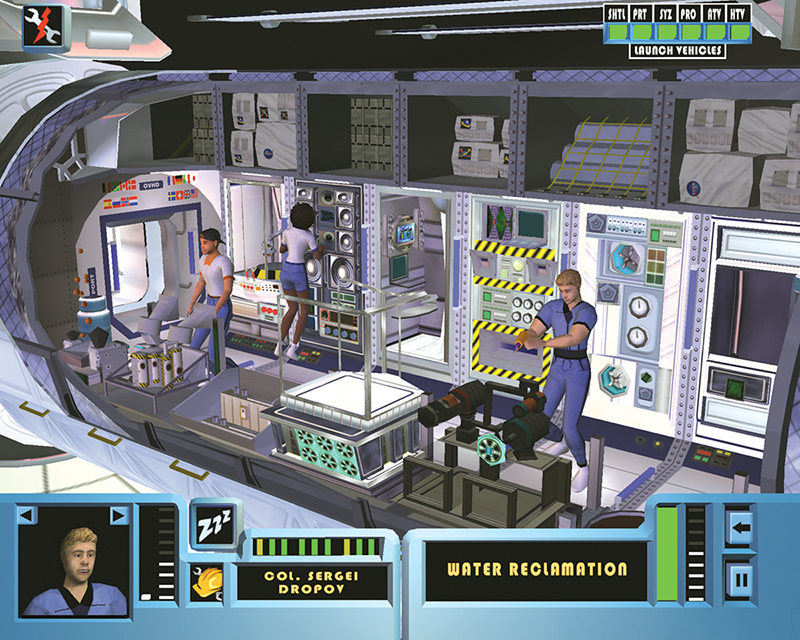
Affordable Space Tourism: SpaceStationSim
Originating Technology/NASA Contribution
For over 5 years, people have been living and working in space on the International Space Station (ISS), a state-of-the-art laboratory complex orbiting high above the Earth. Offering a large, sustained microgravity environment that cannot be duplicated on Earth, the ISS furthers humankind’s knowledge of science and how the body functions for extended periods of time in space—all of which will prove vital on long-duration missions to Mars.
On-orbit construction of the station began in November 1998, with the launch of the Russian Zarya Control Module, which provided battery power and fuel storage. This module was followed by additional components and supplies over the course of several months. In November 2000, the first ISS Expedition crew moved in.
Since then, the ISS has continued to change and evolve. The space station is currently 240 feet wide, measured across the solar arrays, and 171 feet long, from the NASA Destiny Laboratory to the Russian Zvezda Habitation Module. It is 90 feet tall, and it weighs approximately 404,000 pounds. Crews inhabit a living space of about 15,000 cubic feet.
To date, 90 scientific investigations have been conducted on the space station. New results from space station research, from basic science to exploration research, are being published each month, and more breakthroughs are likely to come.
It is not all work on the space station, though. The orbitingaffords many of the comforts one finds on Earth. There is a weightless “weight room” and even a musical keyboard alongside research facilities. Holidays are observed, and with them, traditional foods such as turkey and cobbler are eaten—with lemonade to wash them down.
Partnership
Vision Videogames, LLC, of Towson, Maryland, completed a Space Act Agreement with NASA to create the interactive video game, SpaceStationSim, in which players role-play as the NASA “Chief Administrator,” managing astronauts on the ISS in a 3-D simulated environment. The agreement was a continuation of one between NASA and GRS Games before Vision Videogames management bought the company in March 2004.
The agreement provided, for a set time, the company with information from, and access to, NASA personnel, so that it could make the most accurate game possible. NASA personnel even volunteered to be beta testers for the new game.
Bill Mueller, president of Vision Videogames, said of the project, “The assistance and support from NASA were invaluable, and the enthusiasm of the NASA personnel was great.”
The company also received volunteers of assistance from a variety of space experts and international agencies, including the Japan Aerospace Exploration Agency (JAXA).
With this level of interest, expertise, and involvement, Vision Videogames managed to create a game that is so accurate and realistic that NASA is even exploring aspects of the game for mission planning.
Early in 2005, Vision Videogames worked with Raytheon Company, of Waltham, Massachusetts, to demonstrate the viability of using a simulated systems engineering and integration visualization platform for collaborative development environments. In fall 2005, Vision Videogames completed a contract with NASA to use SpaceStationSim to simulate the creation of the Crew Exploration Vehicle and crew, appropriately named, SimCEV. It is significantly more affordable and safe to model and test equipment and programs in a simulated environment than it is to field test, especially when the field is the Moon or Mars. The SpaceStationSim software engine provided “virtual vehicle” assets, animation, and programming expertise for NASA to support the Vision for Space Exploration.
Product Outcome
SpaceStationSim is the latest in a long line of popular simulation (SIM) games. Precursors include games that allow players to do everything from building a city, an island, or a planet, to attending college, going out on the town at night, or managing an amusement park, to masquerading as rock stars. There is even a SIM variation that allows players to practice looking after pets. While the ISS variation, then, is not that far-fetched, the difference is that it was built to NASA technical specifications and holds all the excitement and intrigue that goes with actually living in space.
“We believe that one real day at NASA is more exciting than an imaginary day anywhere else,” Mueller explains. “We intend to bring to a whole generation of young people a sense of ownership in, and dedication to, NASA.”
As the “Chief Administrator” of NASA, the player creates crewmembers with unique needs, abilities, and personalities, and manages their activities and relationships.
In this game, as in real life, the astronauts face mission-critical situations, including meteor strikes and decompression, while conducting microgravity experiments and dealing with troublesome space tourists. The space tourists, included to offer a bit of comic relief, appear on the station dressed for the beach or boardwalk, in full Hawaiian tourist attire. They disrupt the astronauts as the crew goes about its chores repairing machinery, conducting experiments, and trying to keep happy and healthy in the confines of the space station.
The player monitors the crew as it performs experiments and completes simple repairs. According to the game’s instruction manual, “Through strategy, design, management, discovery, and care of your crew, your ISS may usher in the dawn of a new age for man among the stars or fail in a burning inferno!”
The game begins in the Mission Control Center, which is also where the player returns regularly to launch new modules and components, recruit crewmembers, organize supply missions, and monitor the game’s currency, which is international goodwill, measured in the form of international flags.
The player determines the astronaut’s strengths and weaknesses, and then these factors later come into play on the ISS. If an astronaut is excessively playful and has a poor work ethic, repairs might not be made. If the astronaut, on the other hand, is too focused on work and is not interested in having fun, he may burn out over time and become unhealthy and depressed. The skills and specialties of the astronauts also come into play, as certain specialists are the only ones qualified to perform certain tasks. A biomedical payload specialist, for example, can perform high-level biomedical experiments, whereas an astrotechnology expert may be more adept at certain onsite repairs.
After the astronauts are blasted off to the station on a Russian Soyuz vehicle, the player must manage the astronaut’s activities by assigning tasks to keep them happy, healthy, and productive. The astronauts are able to choose tasks on their own, but initially, they need more guidance or they will make mistakes. Once they have developed more experience, though, they become more self-sufficient, and the player can focus on building the station.
As the game progresses, the player constructs the station, adding additional sections and bringing needed equipment and supplies to the virtual astronauts. The player coordinates with Mission Control to determine which vehicles are available to carry different machinery to the station. A player can chose between dozens of modules and stylized components from NASA and its four exploration partners, JAXA, the Russian Space Agency, the Canadian Space Agency, and the European Space Agency.
Players can add experimental equipment, items to make their lives and stay more comfortable, and can construct their own unique station by building additions and components.
Currently, the game can be played on a personal computer, and a PlayStation 2 version is in development.
PlayStation® is a registered trademark of Sony Computer Entertainment America, Inc.
SpaceStationSim™ is a trademark of Vision Videogames, LLC.
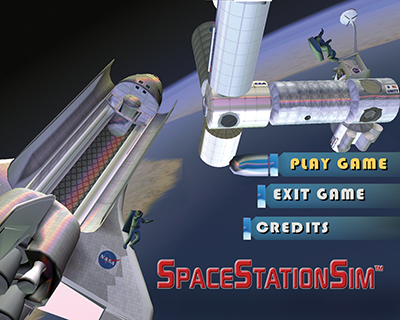
SpaceStationSim allows players to create and manage their very own International Space Station and crew.
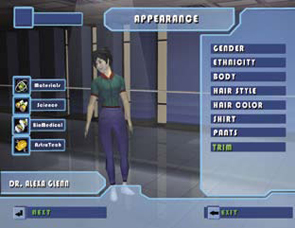
The Astronaut Builder allows players to create and recruit new astronauts for their stations, choosing everything from whether the astronaut will have a green or blue shirt to whether he or she will be skilled in astrotechnology or biomedicine.
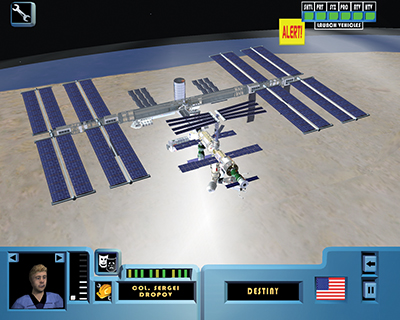
In New Station Mode, players have the freedom to build the International Space Station any way they want, within, of course, the connection rules governing the actual space station
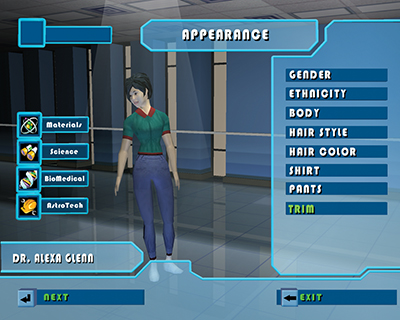
The Astronaut Builder allows players to create and recruit new astronauts for their stations, choosing everything from whether the astronaut will have a green or blue shirt to whether he or she will be skilled in astrotechnology or biomedicine.

To keep the astronauts in peak condition and the station in orbit, players must give astronauts tasks that fulfill their needs as well as those of the station.













